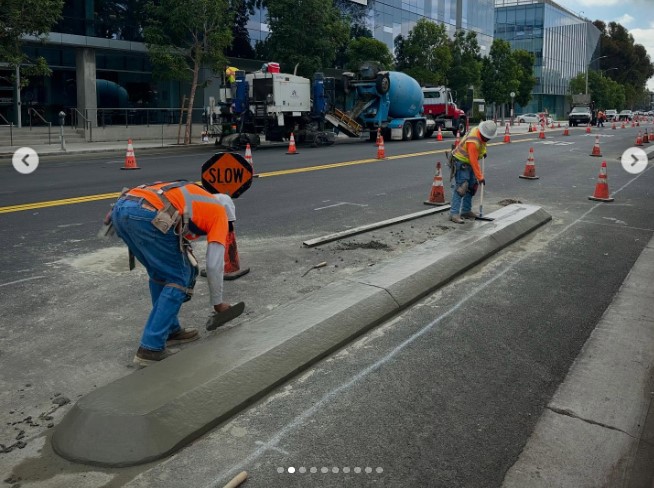(Odysseus Bostick is a Los Angeles teacher and former candidate for the Los Angeles City Council. He writes The Bostick Report for CityWatch.)
Our roads are swiss cheese, our sidewalks are like a broken fault line, our bridges are sagging, and our cars are still the most convenient way to get through the mess.
We’ve gotten to the point where our infrastructure problems are so large in scope and the cost to change this is so high that we really can't pass enough taxes or bonds to cover all of our needs. That's not to say that passing specific bonds isn't necessary.
Upcoming ballot measures within the County of Los Angeles aimed at extending Measure R are not just merited, but crucial to ensuring that all the money we’ve already spent on building a basic network of light isn’t wasted. And finishing our rail lines is just Phase One.
The basic structure of a rail transportation system won’t be the cure-all because logistics prevent even a vast network of rail lines from actually getting people to the places they need to go. Clearly, we need micro-networks to cover areas that rail doesn’t reach.
Some of these solutions are small in scope – like bike share programs, walkable/bikeable design, and the like. Others are larger in scope than that, like a streetcar.
The problem is that bonds and tax increases only go so far and funding the build out of our rail network will consume most of those big scope revenue increases. So we are posed with the question of how to fund the smaller scale, “end of the line” public transportation ecosystems so that a user has access to the nooks and crannies not conveniently located at the base of the train station platform?
Reality is, though many of us might be “hard core” enough to walk that last mile or two, most people will just go back to their car at that point, thus rendering the investments we’ve made in rail a bust. Correspondingly, political reality limits the scope of new bonds or taxes and passing an extension to Measure R will be a Battle Royale.
This mandates that we find creative investment streams to complement the full build out of a truly functional infrastructure network. These can’t all be new revenue streams. Some must be reallocated streams.
One really exciting model I think deserves far more consideration partners government infrastructure investments with public pension plan portfolio allocations to identify portions of the retirement portfolio that could be dedicated to infrastructure projects.
The advantages of this model are many, but my two favorites are the synchronicity of efforts and timelines.
In efforts, you're looking to support livable retirements while investing in infrastructure improvements that build quality of life and foster economic growth in the private sector, which in turn, adds to the general fund in increased tax revenue to build more robust city services and yes, help fund the retirement plans. It's also synchronous in the sense that your public labor force is investing not just a career in their city, but also their retirement security in a well-run city. That mutually beneficial relationship paves the way for a collaborative effort by taxpayers and their public employees.
In timelines, both pension plans and government infrastructure investments of large scope work because they can leverage longer periods of time than a private investment stream. That's why bonds work to fund large scope infrastructure projects (like the transcontinental railroad) and why private capital for those "public good" projects is not relied on. Simply put, private capital needs shorter term profits whereas pension funds and government investments can wait longer to see profit.
This kind of partnership, however, doesn't work for every kind of project mainly because the pension fund does need a quantifiable and reliable profit to be paid at some point. An example of a bad project would be sidewalks. How do you easily identify the kind of profits needed to make a pension pay out when that fund is investing $4.5 billion in road or sidewalk repair? It's tough to quantify the benefit to the pension payout. It’s possible that some creative economist may one day develop a mechanism to do such a thing. All you creative economists listening out there, get to work.
In the meantime, there are infrastructure investment projects in public transportation where you have a quantifiable profit in fares collected.
One project I can't seem to shut up about is a streetcar running down Lincoln and up Venice Blvd to connect the Expo station in Santa Monica with the Expo station in Culver City. That would be a $250 million project with quantifiable investment returns. Partnering with a pension fund like LACERS (operating an $11.4 billion portfolio) would be a win-win for building out a fully integrated infrastructure network, repairing an injured relationship between the city, taxpayers, and our municipal employees, and ensuring that investments by the taxpayers are maximizing public good for the city. The pension fund would, obviously, be a partner in the fare profits in order to ensure the security of the fund.
And I would add that cost efficiencies in running such a streetcar by these public employees would be higher than in a project whose success was not tied directly to their pensions.
While shifting the approach of investments as long range as pension funds takes time, I believe this approach merits strong consideration. The pensions must be funded no matter what, meaning that taxpayers here in the city (and county) must pay for them. It would be intelligent policy if those costs could benefit the taxpayers even more than ensuring a secure retirement for our public sector labor force. It would be great if that investment provided multi-dimensional benefits that foster the growth of our economy as well while ensuring that the tax increases from Measure R are not wasted because we failed to connect riders from the train stations to the places they really wanted to go.






